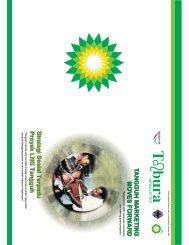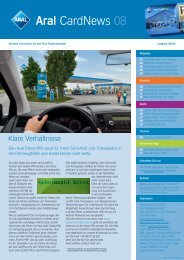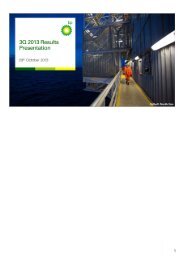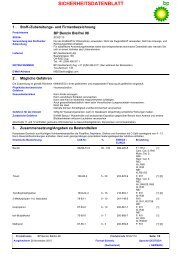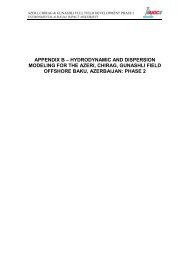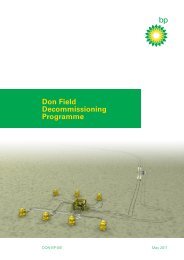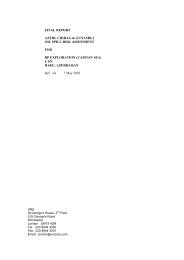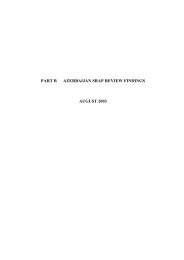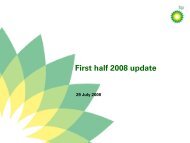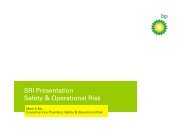BP in Angola Sustainability Report 2010 (pdf, 3860KB)
BP in Angola Sustainability Report 2010 (pdf, 3860KB)
BP in Angola Sustainability Report 2010 (pdf, 3860KB)
Create successful ePaper yourself
Turn your PDF publications into a flip-book with our unique Google optimized e-Paper software.
<strong>BP</strong> <strong>Angola</strong> <strong>in</strong> context<br />
<strong>BP</strong> <strong>Angola</strong> <strong>in</strong> context Work<strong>in</strong>g <strong>in</strong> <strong>Angola</strong>, a develop<strong>in</strong>g<br />
country with a heritage of conflict, creates a demand<strong>in</strong>g operat<strong>in</strong>g<br />
context for bus<strong>in</strong>ess <strong>in</strong> which a variety of economic, physical, and<br />
social challenges affect day-to-day activities<br />
1<br />
2<br />
1 Road side market, Benguela<br />
– Luanda road<br />
2 Luanda – Huambo road<br />
4 <strong>BP</strong> <strong>in</strong> <strong>Angola</strong> Susta<strong>in</strong>ability <strong>Report</strong> <strong>2010</strong><br />
The need to build economic and social capacity<br />
S<strong>in</strong>ce the end of civil war <strong>in</strong> February 2002, <strong>Angola</strong> has rema<strong>in</strong>ed stable and peaceful. The<br />
country is undergo<strong>in</strong>g a transition from a period of long and devastat<strong>in</strong>g conflict, with a<br />
countrywide <strong>in</strong>frastructure reconstruction project and a private and public economic-social<br />
recovery plan.<br />
To date, the transition has successfully provided for national security, and given reasonable<br />
political, military, economic and social stability. However, further development of the country’s<br />
human and <strong>in</strong>stitutional capacity is required <strong>in</strong> order to eradicate poverty and create a more<br />
prosperous society. The UNDP calculates, for example, that 37% of <strong>Angola</strong>ns live <strong>in</strong> poverty <strong>in</strong><br />
<strong>2010</strong>, a significant improvement on the 68% <strong>in</strong> 2001 but reflect<strong>in</strong>g the progress still needed,<br />
which also requires tackl<strong>in</strong>g the more widespread challenge of rural poverty.<br />
Infrastructure development<br />
The years of conflict have left much of the country’s basic services – power and water supplies,<br />
the road and rail network, and health and education systems – <strong>in</strong> poor condition. These pose<br />
daily challenges to the <strong>Angola</strong>n people as well as to bus<strong>in</strong>esses which would like to operate <strong>in</strong><br />
the country. The current lack of a local, skilled workforce and a develop<strong>in</strong>g legal and regulatory<br />
environment can serve as additional constra<strong>in</strong>ts for bus<strong>in</strong>ess development and foreign<br />
<strong>in</strong>vestment.<br />
Economic diversification<br />
With <strong>Angola</strong> be<strong>in</strong>g the second largest oil producer <strong>in</strong> sub-Saharan Africa after Nigeria, the oil<br />
sector cont<strong>in</strong>ues to drive the economy, support<strong>in</strong>g the country’s reconstruction and boost<strong>in</strong>g<br />
foreign <strong>in</strong>vestment. However, strong dependence on the oil sector means that <strong>Angola</strong> is heavily<br />
exposed to the vagaries of global demand. In 2009, for example, the collapse <strong>in</strong> oil prices<br />
contributed to weak GDP growth of around 2% aga<strong>in</strong>st the double-digit growth of the previous<br />
five years. Inflation rema<strong>in</strong>s high, <strong>in</strong>dicat<strong>in</strong>g the high cost of do<strong>in</strong>g bus<strong>in</strong>ess <strong>in</strong> <strong>Angola</strong>.<br />
Economic <strong>in</strong>dicators<br />
2007 2008 2009 <strong>2010</strong> Source<br />
Real GDP growth % 20.3 13.2 2.0 6.7 CEIC/ World Bank<br />
Inflation, annual average % 11.78 13.2 14.0 13.4 <strong>Angola</strong> Central Bank<br />
Currency (exchange rate) 75.0 75.1 88.7 92.0 <strong>Angola</strong> Central Bank<br />
OPEC basket price, $/barrel 69.0 94.4 61.0 76.2 OPEC<br />
<strong>Angola</strong> oil production (mbd) 1.6 1.9 1.9 1.7 Sonangol<br />
To address this challenge, the government plans to promote growth <strong>in</strong> the non-oil sector, with<br />
<strong>in</strong>itiatives to improve performance and <strong>in</strong>vestment levels <strong>in</strong> agriculture and manufactur<strong>in</strong>g.<br />
<strong>Angola</strong> has announced <strong>in</strong>vestments of more than $8 billion <strong>in</strong> the next four years to bolster its<br />
economic transformation. The plan is to allocate $4 billion to <strong>in</strong>dustries aimed at <strong>in</strong>creas<strong>in</strong>g<br />
exports and to reduce imports of a range of products from food to build<strong>in</strong>g materials.<br />
<strong>BP</strong> <strong>in</strong> <strong>Angola</strong> recognises the risk of over-reliance on the oil and gas <strong>in</strong>dustry, and the need<br />
to manage the high expectations that stakeholders have of the oil and gas <strong>in</strong>dustry. While our<br />
key contribution lies <strong>in</strong> maximis<strong>in</strong>g oil and gas production (and hence government revenues), we<br />
play a support<strong>in</strong>g role <strong>in</strong> related areas. For example, we support economic diversification by<br />
buy<strong>in</strong>g goods and services from local suppliers, develop<strong>in</strong>g the skills of the local labour force,<br />
and promot<strong>in</strong>g education and enterprise development <strong>in</strong> our social <strong>in</strong>vestment programmes.


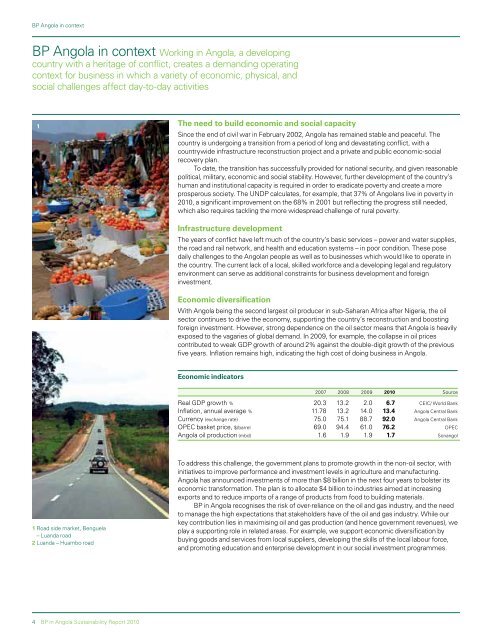
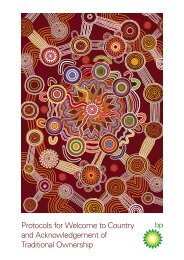
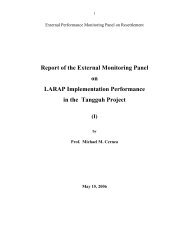
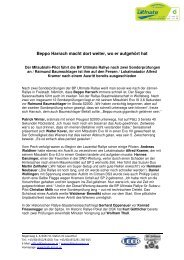
![[PDF] Deepwater Horizon: Accident Investigation Report - BP](https://img.yumpu.com/51697031/1/190x245/pdf-deepwater-horizon-accident-investigation-report-bp.jpg?quality=85)
